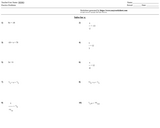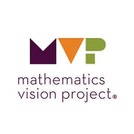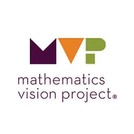
This resource provides problems for students to solve simple linear equations in terms of x.
- Subject:
- Math 3
- Mathematics
- Material Type:
- Lesson Plan
- Provider:
- Triple Threat, Inc.
- Author:
- Easy Worksheet
- Date Added:
- 04/04/1998

This resource provides problems for students to solve simple linear equations in terms of x.

This task is designed to serve two purposes: 1) to motivate deeper thinking and develop fluency with operations on polynomials, and 2) to formalize the definition of a polynomial and understand that polynomials are closed under addition, subtraction, and multiplication. The task begins with the definition of polynomial and carefully contrasting the features of polynomials with other functions. Students are then asked to consider various conjectures about polynomials and use examples to demonstrate that a conjecture is true or provide a counterexample to prove that the conjecture is false.

The purpose of this task is to solidify students’ previous understanding of radians—that is, the radian measure of an angle is the ratio of the length of an intercepted arc to the radius of the circle on which that arc lies, and to use radian measurement as a proportionality constant in computations. This task and the previous task lay a foundation for a new understanding of radians —that is, the radian measure of an angle is the length of the intercepted arc on a unit circle. This latter idea will be solidified in the next task of this learning cycle.

Website link that provides instruction on "Sums of Finite Geometric Series". Students may review the topic by reading notes and examples, using flashcards, watching a video, or through the use of a student -created study guide.

Students will synthesize what they have learned about functions to select the correct function type in a series of modeling problems. Students must also draw on their study of statistics, using graphs and functions to model a context presented with data and/or tables of values. In this module, the modeling cycle is used as the organizing structure, rather than function type.

The purpose of this task is for students to analyze and make sense of data. Students will connect their prior understandings of tree diagrams and frequency tables (from earlier grades) to analyze data from a tree diagram and explain the results to others. The focus of this task is to highlight the information revealed as a result of the conditional probability statements. Questions such as ‘How does the subgroup information tell us a more complete story?’ should be addressed in this task.

In this task students examine another solid of revolution—a frustum—and create a strategy for finding its volume. They then use a variety of strategies to decompose a figure that consists of curved edges into cylinders, frustums and cones to generate a sequence of better and better approximations of the actual volume of the solid.

The purpose of this task is two-fold:
1. To extend the ideas of inverse to exponential functions.
2. To develop informal ideas about logarithms based upon understanding inverses. (These ideas will be extended and formalized in Module II: Logarithmic Functions)
The first part of the task builds on earlier work in Secondary I and II with exponential functions. Students are given an exponential context, the distance travelled for a given time, and then asked to reverse their thinking to consider the time travelled for a given distance. After creating a graph of the situation, students are asked to consider the extended domain of all real numbers and think about how that affects the inverse function. Questions at the end of the task press on understanding of the inverse relationship and the idea that a function and its inverse “undo” each other, using function notation and particular values of a function and its inverse.

Resources for Transforming different polynomial, absolute value, exponential and logarithmic functions.

This online tutorial provides instruction and practice items on trigonometric identities such as sine, cosine, and tangent.

Students distinguish between observational studies, surveys and experiments. Students explain why random selection is an important consideration in observational studies and surveys, and why random assignment is an important consideration in experiments. Students recognize when it is reasonable to generalize the results of an observational study or survey to some larger population, and when it is reasonable to reach a cause-and-effect conclusion about the relationship between two variables.

This lesson requires students to explore quadratic functions by examining the family of functions described by y = a (x - h)^2 + k. This lesson plan is based on the activity Tremain Nelson used in the video for Part I of this workshop.

This online tutorial provides instruction and practice items on using rational expressions.

This lesson teaches students about inverse variation by exploring the relationship between the heights of a fixed amount of water poured into cylindrical containers of different sizes as compared to the area of the containers' bases.

The purpose of this task is to practice finding the sine and cosine of angles of rotation on the unit circle when the angle is measured in radians counterclockwise from the ray passing through the point (1, 0); that is, angles drawn in standard position.

The purpose of this task is two-fold: to model a situation using rational functions, and to solve equations that contain rational expressions. Students will write a rational equation to answer a question about combined rates. They will develop strategies to solve rational equations using their previous work with rational expressions.

The purpose of this task is to introduce students to rational functions and to explore the behavior of a function, that produces vertical and horizontal asymptotes.

This lesson will teach students to factor trinomial expressions of the form x^2 + bx + c. Students will use algebra tiles to identify the binomial factors and the graphing calculator to verify the result. In addition, students will identify the x-intercepts and y-intercepts of each trinomial function and explore relationships between the trinomial x^2 + bx + c and its factored form (x + m)(x + n).

This task provides an opportunity for students to solidify their understanding of solids of revolution in a problem-solving, modeling context. Students will decompose a geometric solid of revolution into familiar three-dimensional objects whose volumes can be calculated. Students will also need to draw upon their ability to reason with units when solving problems.

The purpose of this task is to examine and extend ideas about cubic functions that were surfaced in 3.1 Scott’s Macho March Madness. Students consider a basic cubic function, identifying its characteristics and graph. Students will recognize that the graph can be transformed using the same techniques as quadratic functions. Students will also make other comparisons between cubic and quadratic functions, specifically, their end behavior and the values of each function when # is a fraction.